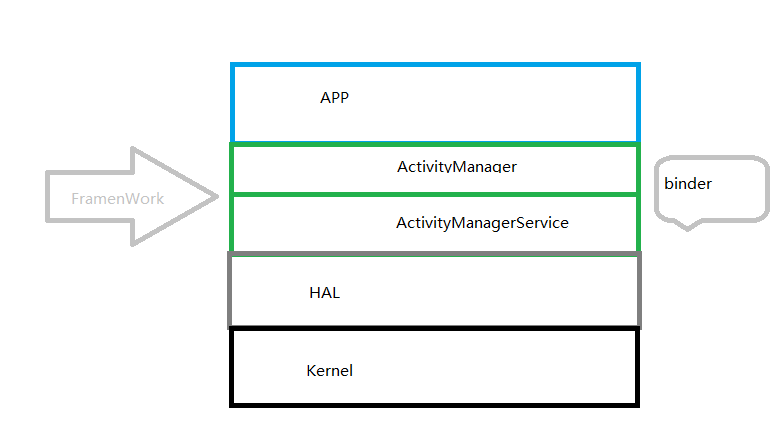Android源码分析(十三)ActivityManagerService服务分析
一.ActivityManagerService(AMS) 启动过程分析
在SystemServer启动ActivityManagerService
如果想了解SystemServer启动过程可以看这篇文章:Android 源码分析(六) SystemServer 进程
frameworks\base\services\java\com\android\server\SystemServer.java // Activity manager runs the show. traceBeginAndSlog("StartActivityManager"); mActivityManagerService = mSystemServiceManager.startService( ActivityManagerService.Lifecycle.class).getService(); mActivityManagerService.setSystemServiceManager(mSystemServiceManager); mActivityManagerService.setInstaller(installer);
frameworks\base\services\core\java\com\android\server\am\ActivityManagerService.java
public class ActivityManagerService extends IActivityManager.Stub implements Watchdog.Monitor, BatteryStatsImpl.BatteryCallback { /** All system services */ SystemServiceManager mSystemServiceManager; /** Run all ActivityStacks through this */ //管理Activity final ActivityStackSupervisor mStackSupervisor; final ActivityStarter mActivityStarter; final TaskChangeNotificationController mTaskChangeNotificationController; final InstrumentationReporter mInstrumentationReporter = new InstrumentationReporter(); final ArrayList<ActiveInstrumentation> mActiveInstrumentation = new ArrayList<>(); // Whether we should use SCHED_FIFO for UI and RenderThreads. private boolean mUseFifoUiScheduling = false; //Broadcast 广播 ,前台广播队列和后台广播队列 BroadcastQueue mFgBroadcastQueue; BroadcastQueue mBgBroadcastQueue; // Convenient for easy iteration over the queues. Foreground is first // so that dispatch of foreground broadcasts gets precedence. final BroadcastQueue[] mBroadcastQueues = new BroadcastQueue[2]; BroadcastStats mLastBroadcastStats; BroadcastStats mCurBroadcastStats; BroadcastQueue broadcastQueueForIntent(Intent intent) { final boolean isFg = (intent.getFlags() & Intent.FLAG_RECEIVER_FOREGROUND) != 0; if (DEBUG_BROADCAST_BACKGROUND) Slog.i(TAG_BROADCAST, "Broadcast intent " + intent + " on " + (isFg ? "foreground" : "background") + " queue"); return (isFg) ? mFgBroadcastQueue : mBgBroadcastQueue; } //Activity 堆栈 /** * The last resumed activity. This is identical to the current resumed activity most * of the time but could be different when we're pausing one activity before we resume * another activity. */ private ActivityRecord mLastResumedActivity; /** * If non-null, we are tracking the time the user spends in the currently focused app. */ private AppTimeTracker mCurAppTimeTracker; //ANR ? 最后个ANR状态,难道可以记录app发生ANR的? /** * Dump of the activity state at the time of the last ANR. Cleared after * {@link WindowManagerService#LAST_ANR_LIFETIME_DURATION_MSECS} */ String mLastANRState; //Service 和 Provider 管理 final ActiveServices mServices; final ProviderMap mProviderMap; //存放系统数据目录 // TODO: Move creation of battery stats service outside of activity manager service. File dataDir = Environment.getDataDirectory(); File systemDir = new File(dataDir, "system"); systemDir.mkdirs(); mBatteryStatsService = new BatteryStatsService(systemDir, mHandler); //应用权限管理 mAppOpsService = mInjector.getAppOpsService(new File(systemDir, "appops.xml"), mHandler); //AcitivityManager 添加进来 ServiceManager.addService(Context.ACTIVITY_SERVICE, this, true); ServiceManager.addService(ProcessStats.SERVICE_NAME, mProcessStats); ServiceManager.addService("meminfo", new MemBinder(this)); ServiceManager.addService("gfxinfo", new GraphicsBinder(this)); ServiceManager.addService("dbinfo", new DbBinder(this)); if (MONITOR_CPU_USAGE) { ServiceManager.addService("cpuinfo", new CpuBinder(this)); } ServiceManager.addService("permission", new PermissionController(this)); ServiceManager.addService("processinfo", new ProcessInfoService(this)); //最后 使用Watchdog监控 Watchdog.getInstance().addMonitor(this); Watchdog.getInstance().addThread(mHandler); }
从上面截取的一些代码片段,我们能了解到, AMS创建过程 涉及到Android 四大组件管理的初始化工作。并且ActivityManagerService extends IActivityManager.Stub,所以可知AcitivityManagerService与AcitivityManager之间通信也是使用binder机制。
进ActivityManager 里面看看
//与ActivityManagerService里的ServiceManager.addService(Context.ACTIVITY_SERVICE, this, true);对应。 @SystemService(Context.ACTIVITY_SERVICE) public class ActivityManager { ... }
二.ActivityManager和ActivityManagerService关系
如果想了解Activity是如果通过ActivityManager调用ActivityManagerService的过程可以看下这篇文章.
ActivityManager(frameworks/base/core/java/android/app/ActivityManager.java)
ActivityManager 是客户端用来管理系统中正在运行的所有Activity.
上层APP通过ActivityManager使用binder机制传递信息给AMS,由AMS去完成交互和调度工作后通过binder机制返回给ActivityManager,把结果在返回给上层app。
一张图了解ActivityManager和ActivityManagerService在整个Android系统通信过程中位置。

参考:
[1]https://www.cnblogs.com/bastard/p/5770573.html




【推荐】还在用 ECharts 开发大屏?试试这款永久免费的开源 BI 工具!
【推荐】国内首个AI IDE,深度理解中文开发场景,立即下载体验Trae
【推荐】编程新体验,更懂你的AI,立即体验豆包MarsCode编程助手
【推荐】轻量又高性能的 SSH 工具 IShell:AI 加持,快人一步